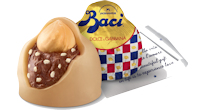Our network:
Saturday 8 November 2025
The Basilica of St Claire
Construction work on the church and adjacent convent of St Claire began in 1257, three years after the saint's death and a year after she was canonised.
Until then the sisters of St Claire had lodged at San Damiano. The church dedicated to St Claire occupied the site of the church of San Giorgio, where St Francis had been buried before his remains were moved to the basilica in 1230.
The exterior of the building makes use of alternate strips of pink and white stone, with massive supporting arches either side.
The interior has the same layout as the Upper Basilica of St Francis, with a single nave that terminates in a transept and polygonal apse. Like St Francis', a gallery runs the entire perimeter of the church, although here it is on the same level as the capitols. On the right hand side of the nave the Cappella del Crocifisso and the Cappella del Sacramento were once part of the nave of the previously existing church of San Giorgio, where Pope Gregory IX canonised St Francis in 1228.
The wooden "Crucifix“ in the Cappella del Crocifisso is alleged to have spoken to St Francis in San Damiano, ordering him to repair the church. Relics of St Francis and St Claire are kept behind the grate. The following chapel contains a fresco by Puccio Capanna (1340-46): "Enthroned Madonna and Child with St Claire, St John the Baptist, the Archangel Michael and St Francis", as well as other frescoes of the school of Giotto and Lorenzetti.
The right hand transept contains a panel with the "Life of St Claire“, by the so-called Maestro di Santa Chiara (late 13th century), as well as frescoes depicting St Claire and Biblical scenes by an artist known as the Maestro Espressionista di Santa Chiara (first half of the 14th century). The "Crucifix“ in the apse has also been attributed to the Maestro di Santa Chiara (1280-90).
A colonnade of 12 polygonal columns carved by a local workman in the 15th century encloses the high altar. The wrought iron dividing curtain is 17th century. A detached 14th century fresco of the "Nativity“ displays influences of Giotto in the left hand transept.
The Byzantine style Hodegetria type panel on the left hand wall depicts the "Madonna and Child“ and is by an unknown artist from the 13th century. The lunettes are decorated with scenes from the Old Testament similar to those in the upper cycle of the Upper Basilica of St Francis (late 13th century).
The crypt was built between 1850 and 1872. Restored in neo-gothic style in 1935, it houses the body of St Claire, disovered in 1850.
Until then the sisters of St Claire had lodged at San Damiano. The church dedicated to St Claire occupied the site of the church of San Giorgio, where St Francis had been buried before his remains were moved to the basilica in 1230.
 |
The exterior of the building makes use of alternate strips of pink and white stone, with massive supporting arches either side.
The interior has the same layout as the Upper Basilica of St Francis, with a single nave that terminates in a transept and polygonal apse. Like St Francis', a gallery runs the entire perimeter of the church, although here it is on the same level as the capitols. On the right hand side of the nave the Cappella del Crocifisso and the Cappella del Sacramento were once part of the nave of the previously existing church of San Giorgio, where Pope Gregory IX canonised St Francis in 1228.
The wooden "Crucifix“ in the Cappella del Crocifisso is alleged to have spoken to St Francis in San Damiano, ordering him to repair the church. Relics of St Francis and St Claire are kept behind the grate. The following chapel contains a fresco by Puccio Capanna (1340-46): "Enthroned Madonna and Child with St Claire, St John the Baptist, the Archangel Michael and St Francis", as well as other frescoes of the school of Giotto and Lorenzetti.
The right hand transept contains a panel with the "Life of St Claire“, by the so-called Maestro di Santa Chiara (late 13th century), as well as frescoes depicting St Claire and Biblical scenes by an artist known as the Maestro Espressionista di Santa Chiara (first half of the 14th century). The "Crucifix“ in the apse has also been attributed to the Maestro di Santa Chiara (1280-90).
A colonnade of 12 polygonal columns carved by a local workman in the 15th century encloses the high altar. The wrought iron dividing curtain is 17th century. A detached 14th century fresco of the "Nativity“ displays influences of Giotto in the left hand transept.
The Byzantine style Hodegetria type panel on the left hand wall depicts the "Madonna and Child“ and is by an unknown artist from the 13th century. The lunettes are decorated with scenes from the Old Testament similar to those in the upper cycle of the Upper Basilica of St Francis (late 13th century).
The crypt was built between 1850 and 1872. Restored in neo-gothic style in 1935, it houses the body of St Claire, disovered in 1850.
| Up |
General information
• Assisi World Heritage • Churches
• Associations & Groups
• History
• Tourist Guides and visit guided in Umbria
• General travel tips
• Useful - emergency numbers
• Weather information
• Lyrick Theatre Assisi
• Metastasio Theatre Assisi
• Local opening times
• Churches of Assisi
Transport in town
• Streets of Assisi • Traffic restrictions
• Parking Mojano - historic centre
• Parking (others)
• Buses & Taxis
• Town map
• How to reach Assisi by car
• How to reach Assisi by Train
• How to reach Assisi by Air
Transport out of town
• Airport • Rent-a-car
• Local and national buses
Where to Stay
• Hotel Panda • Holiday Farm Colle degli Olivi
• Map of Hotels in Assisi

Where to eat and drink
• Restaurant Colle degli Olivi • Restaurants Map of Assisi area
Education
• Italian Language School for Foreigners • University
Art and monuments
• The Rocca Maggiore • Temple of Minerva
• Palazzo Capitano del Popolo
• Roman Amphitheatre
Art and religion
• Eremo delle Carceri • The Basilica of St Francis and the Sacro Convento
• The Basilica of Santa Maria degli Angeli
• The Basilica of St Claire
• Abbey of St. Pietro
• St. Damian's Convent
• St. Rufino Cathedral
• Church of Santa Maria Maggiore
• St. Francis of Assisi - 2, 3 and 4 October

News from Assisi
Sorry, non news - i soggetti interessati a far conoscere le iniziative che avranno luogo nell'ambito del territorio comunale sono invitati a darne comunicazione con congruo anticipo utilizzando l'email redazione@umbriaonline.com


What to see & do
• 4th OCTOBER, Feast of San Francesco of Assisi • Italian Language School for foreigners
• Park of Colfiorito
• Perugino exhibition and the Porziuncola chapel in Santa Maria degli Angeli - Assisi
• Golfing holidays
• Assisi Farm Stay Colle degli Olivi
• Sapori Tipici Umbri, buy now
Lake Trasimeno
• General Information Lake Trasimeno • The islands - boat tours Lake Trasimeno
• Eating well by Lake Trasimene
• Where to stay by Lake Trasimene
• Bathing - Lake Trasimeno
• Mooring Lake Trasimeno
• Navigation regulations
• Mercati Ittici
Specials - In & Out of town
• Weddings in Umbria • Wellness in Umbria - Assisi area
• Honeymooning in Umbria

Typical products
• Sapori Tipici Umbri • Norcia Ham IGP
• Mushrooms selling
• Truffles selling
• Extra Virgin Olive Oil selling
• Wine selling
Museums and galleries
• The Porziuncola Museum • Cathedral Museum and Crypt of St Rufino
• Municipal Art Gallery
• Treasure Museum & F.M. Perkins Collection
• Civic Museum & Roman Forum
Art and tourist attractions
• Forest of Saint Francis - Assisi - FAI • Along Via San Francesco
• Park of Mount Subasio
• The Calendimaggio :
the Ides of May Festivity







